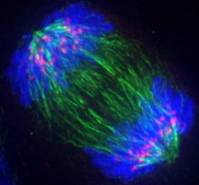Anaphase
Stages of Mitosis
|
|
EUGENE M. MCCARTHY, PHD GENETICS
 Anaphase: Chromosomes (blue), kinetochores (pink), microtubules (green).
Anaphase: Chromosomes (blue), kinetochores (pink), microtubules (green).
Previously, during metaphase, spindle fibers (which are microtubules) attach themselves to the centromere of each chromosome. Specifically, the connection is to specialized regions called kinetochores within the centromeres. Each chromatid has one kinetochore. By the end of metaphase, all of the chromosomes have moved to an imaginary plane, known as metaphase plate, which lies on the equator of the cell.
Now, during anaphase, the two sister chromatids of each chromosome are pulled apart by the spindle
and dragged by their kinetochores toward opposite poles of the cell, that is, toward the opposite centrosomes. The movement results from a shortening of the spindle microtubules. Each chromosome is pulled along by its centromere. Formally, this phase begins when the duplicated centromeres of each pair of sister chromatids separates, and the resulting "daughter chromosomes" begin moving toward the poles. As the separated chromosomes move away from each other toward the poles, the cell elongates and the poles themselves move further apart.
The terms prophase, metaphase, and anaphase were coined by the Polish-German botanist Eduard Strasburger (Strasburger 1884, pp. 250 and 260), who together with Walther Flemming (1843-1905) and Edouard van Beneden (1846-1910) was the first to describe the process of chromosome distribution during cell division (telophase was only later given a distinct name). In Strasburger's description, metaphase continued until the daughter chromosomes were entirely separate from each other, whereas today it is usually regarded as ending as soon as the kinetochores begin to move towards the poles. Ana is a Greek word meaning, among other things, back, which to Strasburger referred to the chromosomes moving back into compacted nuclei. Strasburger also originated the terms cytoplasm and nucleoplasm, and was the first to accurately describe the embryo sac and to demonstrate double fertilization in angiosperms. He also originated the well-known rule that new cell nuclei can only arise from the division of preexisting ones.
Cited reference: Strasburger, E. 1884. Die Controversen der indirecten Kerntheilung. Archiv f端r mikroskopische Anatomie 23:246-304.
Most shared on Macroevolution.net:
Human Origins: Are we hybrids?
On the Origins of New Forms of Life
Mammalian Hybrids
Cat-rabbit Hybrids: Fact or fiction?
Famous Biologists
Dog-cow Hybrids
Georges Cuvier: A Biography
Prothero: A Rebuttal
Branches of Biology
Dog-fox Hybrids